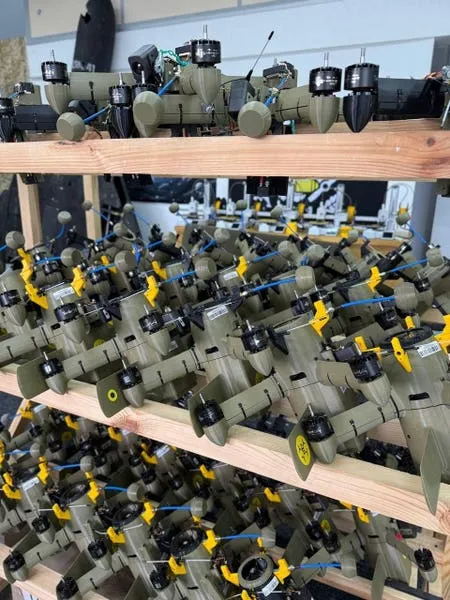Forbes contributors publish independent expert analyses and insights.
Ukraine's Defense Procurement Agency has signed contracts for 'tens of thousands' of interceptor drones, according to director Arsen Zhumadilov speaking in an interview published on July 14.
The U.S. decision to supply more Patriot air defence missile batteries to Ukraine is vital to protect against Russian missiles. But stopping the massive drone onslaught is a job for far more numerous interceptor drones.
The strength of the Iranian-designed Shahed drones lies in their vast numbers. The low-cost drones fly at around 120 mph, with similar performance to a WW1 aircraft, and are just as easy to shoot down. The problem is the sheer volume of them. In June Russia launched over 5,000 Shahed-type drones (this includes smaller Gerbera and Parodiya types). The highest number in one night was 728.
This is far too many for system like Patriot to handle. The U.S. total production capacity is only around 650 Patriot missiles per year. These missiles cost $3.3 million each - roughly 100 times as much as a Shahed.
Patriots are still needed to counter Russia's ballistic and cruise missiles, of which 181 were launched last month . These pose a major threat in addition to the drones. But Shaheds require something that can be scaled up as rapidly as the Russians can make their attack drones.
Previously relied on mobile fire groups equipped with anti-aircraft machineguns, thermal imagers and tablet computers. These groups were linked them to a nationwide command-and-control and sensor system which tracks the slow-moving Shaheds. But the Shaheds have switched tactics, flying at 10,000 feet or more, above the ceiling of antiaircraft fire, and plunging down vertically when they reach the target. The rate of downing Shaheds dopped from 95% or more to 86% last month, so around three times as many were getting through.
Machineguns cannot reach Shaheds flying at altitude. But small, fast interceptor drones can.
As we have seen, in 2024 Ukraine was rapidly modified its ground attack FPV drones, turning them into interceptors to bring down Russian reconnaissance drones. Previously almost immune, the Russian fixed-wing drones were soon being brought down by the hundred. The interceptor pilots, adapting air-to-air dogfighting tactics, became expert in taking out Russian drones , denying them the ability to see targets and direct artillery, rockets, missiles and drone strikes.
It was a small step from reconnaissance drones to Shaheds. The attack drones are more massive, at over 400 pounds, and fly slightly higher and faster than the original FPV interceptors. This has required some design modifications, and we have seen aerodynamic bullet-shaped quadcopters (like Wild Hornet's Sting interceptor) and delta-winged arrow shapes as well as traditional designs.
Prices quoted are in the region of $1,000- $5,000 depending on speed, range and endurance, many acquired via private fundraisers like Serhii Sternenko
Crucially, production can be rapidly scaled up to meet the magnitude of the threat.
But while we know there are lot of Shahed interceptors out there, operational security meant that very little information has been released. Basically, there has been a news blackout on Shahed interceptor operations until now. There have been a few reports of Shaheds brought down by drones and some alleged videos but little official information.
That may be changing. This week President Zelensky praised the work on interceptor teams, noting on his Facebook page that "Interceptor drones are performing especially well -- already hundreds of Russian-Iranian Shahed drones have been shot down this week."
Interestingly we have more from the other side.
Alexey Rogozin. CEO of Russia's United Aircraft Corporation claimed on his Telegram channel media that Ukrainian interceptor drones had downed over 500 Shaheds under the 'Clear Sky' initiative to defend Kyiv, using drones guided by radar and visual systems.
"In a few months since its launch, the system has intercepted more than 500 Geran [i.e. Shahed] attack drones," according to Rogozin. "In fact, we are talking about an urban anti-drone dome built on the mass use of small-sized interceptors, primarily FPV drones. The system includes calculations on vehicles, a monitoring and coordination center and a training center."
Rogozin is confident that big enough waves of Shaheds can break through the interceptors, but notes that they reverse the previous cost equation. Now it is more expensive to attack than to defend.
Knocking out hundreds of Shaheds is an achievement, but with Zhumadilov's announcement deployment will shift to a much larger scale.
"Tens of thousands [of interceptor drones]. This is what we have already contracted and will continue to contract. Our contracting now, on the one hand, depends on the manufacturer's capacity, and on the other hand, on the state budget's capacity," Zhumadilov told Ukrainian outlet Babel. "We will definitely contract everything that the state budget can afford."
Zhumadilov also said that is a manufacturer can produce more drones than Ukraine can afford, they could be funded by allied countries.
This is in line with comments made by President Zelensky last month at the G7 summit when he said that Ukraine has the drone interceptor technology but would need assistance to scale it up. He noted that the interceptor technology would benefit other countries. This is not likely to be the last war featuring massed long-range drone barrages.
Russia's drone attacks have scaled up by a factor of ten in the past year. The interceptor effort is ramping up to match it, and looks like the best hope for stemming the rising civilian casualties returning to the days of 95%+ interception rates. The best hope, that is, until Ukraine's long-range attacks can take out Shahed production centers and stop the problem at its source.
